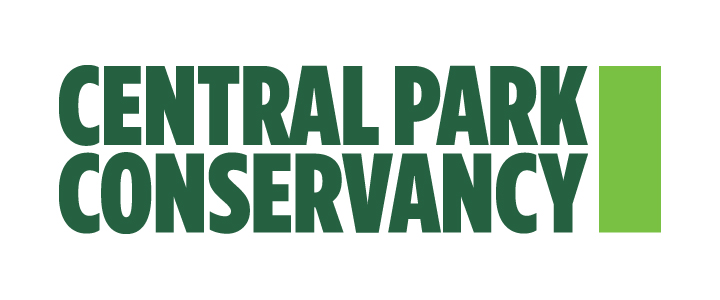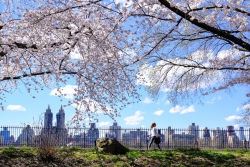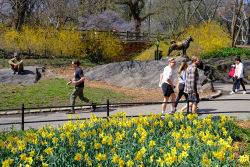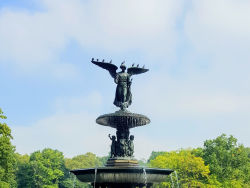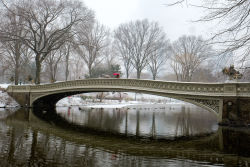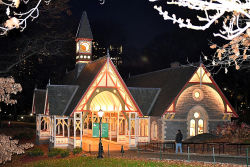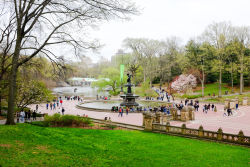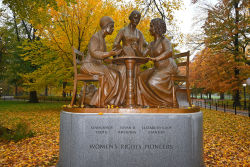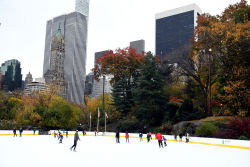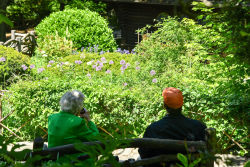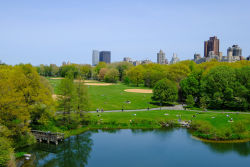Central Park
Ancient Playground
This site is one of the many adventure playgrounds built in New York City throughout the 1960s and 70s. The playgrounds were inspired by European children, who created their own play equipment using the rubble and debris left behind in cities bombed during World War II (1939-45). This phenomenon was incorporated into British and Scandinavian playlots, which were designed to encourage children to modify their surroundings, thereby creating a more participatory play environment. Ancient Playground is one of six adventure playgrounds by architect Richard Dattner in Central Park.
The first playground of this type in New York was Central Park’s Sixty Seventh Street Adventure Playground (1967). The park, designed by Richard Dattner, was a radical departure from the playgrounds built under the direction of Parks Commissioner Robert Moses (1888-1981). Although Moses increased the number and overall quality of the City’s playgrounds, he built virtually all of them with standardized slides, swings, and climbing bars that were criticized for their uniformity.
These antiseptic Moses structures inspired the creation of parks such as Ancient Playground, which invokes Egyptian themes in its play equipment and the use of sand and water. The playground’s pyramid-like play equipment represents the adjacent Temple of Dendur. Built around 15 B.C., the temple contains carvings of a “pharaoh” making offerings to the Egyptian gods Isis, Osiris, and Horus. Yet the pharaoh depicted is actually Emperor Cesar Augustus of Rome wearing traditional Egyptian garments. Augustus is pictured due to his conquest of Egypt in 30 B.C., which brought Egypt under the domain of the Roman Empire. The defeat led to the suicide of Cleopatra VII, the last Ptolemaic ruler of Egypt, and left the Romans in power until their defeat at the hands of the Arabs in 641 A.D.
Building on a similar theme, the park contains a spray shower that represents Egypt’s Nile River. The world’s longest river, the Nile begins in Lake Victoria in Burundi and eventually flows through a 160-mile wide delta into the Mediterranean Sea. The river has two major tributaries, the White and Blue Nile, which join in the Sudanese capital of Khartoum before the river flows down six cataracts, or waterfalls, and into the Mediterranean Sea. These features are depicted by the playground’s spray shower, which starts high in the air before spraying water down several steps into a sandy area representing the delta and Mediterranean. The park’s extensive sand area also draws a parallel to Egypt’s arid landscape.
The playground also contains obelisks that are an allusion to Cleopatra’s Needle, a structure originally erected around 1500 B.C. under orders from the Egyptian king Thothmes III that now resides at East Drive and 82nd Street. The obelisks are related to Cleopatra in name only, as they were transported to her home city of Alexandra 20 years after her death. In 1877, Egyptian ruler Khedive Ismail promised one of these to the United Sates as a token of appreciation for American aid in the construction of the Suez Canal (1869) and to encourage American investment in Egypt. The obelisk arrived in New York on July 20, 1880 and was moved through Manhattan over the course 112 days, an incredibly slow pace that translates to 97 feet per day. The obelisk was finally raised in January of 1881 before more than 10,000 spectators.
Ancient Playground was built when the expansion of the adjacent Sackler Wing of the Metropolitan Museum of Art necessitated the demolition of a nearby playground. The park formerly contained bronze gates featuring bronze figures, designed by Paul Manship, containing scenes from Aesop’s Fables. Ancient Playground now contains different gates, near the rear of the park, that serve as a monument to the park’s former namesake, William Church Osborn (1862-1951). Both Ancient Playground and its adventure playground predecessor at 67th street were designed by Richard Dattner and financed by the Estée and Joseph Lauder Foundation. In addition to its Egyptian-theme play equipment, the park contains a public restroom, turtle animal art, four tire swings and nine slides that make the park one of New York’s most unique play experiences. The other Dattner playgrounds in Central Park are Adventure Playground at West 67th Street, the Water Playground and Heckscher Playground at West 59th Street, The 72nd Street Playground, and the Wild West Playground at West 91st Street.
Check out your park's Vital Signs
Clean & Safe
Green & Resilient
Empowered & Engaged Users
Share your feedback or learn more about how this park is part of a
Vital Park System
Contacts
Central Park Information: (212) 310-6600
Central Park Information (for the Hearing Impaired): (800) 281-5722
Belvedere Castle, The Henry Luce Nature Observatory: (212) 772-0210
The Charles A. Dana Discovery Center: (212) 860-1370
The Dairy Visitor Center and Gift Shop: (212) 794-6564
North Meadow Recreation Center: (212) 348-4867
Loeb Boathouse (Bike rentals, boat rentals & gondolas): (212) 517-2233
Carousel: (212) 879-0244
Fishing at Harlem Meer (Catch & Release): (212) 860-1370
Harlem Meer Performance Festival: (212) 860-1370
Horseback Riding - Claremont Stables: (212) 724-5100
Metropolitan Opera (Performances on the Great Lawn): (212) 362-6000
New York Philharmonic (Performances on the Great Lawn): (212) 875-5709
Shakespeare in the Park - The Public Theater at the Delacorte Theater: (212) 539-8655
Central Park SummerStage: (212) 360-2777
Swedish Cottage Marionette Theater: (212) 988-9093
Tennis: (212) 280-0205
Weddings, Ceremonies and Photography at the Conservatory Garden: (212) 360-2766
Wildlife Center & Tisch Children's Zoo: (212) 439-6500

